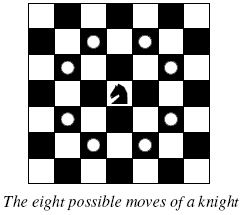来源:http://poj.org/problem?id=2488
A Knight's Journey
| Time Limit: 1000MS | Memory Limit: 65536K | |
| Total Submissions: 30588 | Accepted: 10479 |
Description
 Background
Background
The knight is getting bored of seeing the same black and white squares again and again and has decided to make a journey
around the world. Whenever a knight moves, it is two squares in one direction and one square perpendicular to this. The world of a knight is the chessboard he is living on. Our knight lives on a chessboard that has a smaller area than a regular 8 * 8 board, but it is still rectangular. Can you help this adventurous knight to make travel plans?
Problem
Find a path such that the knight visits every square once. The knight can start and end on any square of the board.
Input
The input begins with a positive integer n in the first line. The following lines contain n test cases. Each test case consists of a single line with two positive integers p and q, such that 1 <= p * q <= 26. This represents a p * q chessboard, where p describes how many different square numbers 1, . . . , p exist, q describes how many different square letters exist. These are the first q letters of the Latin alphabet: A, . . .
Output
The output for every scenario begins with a line containing "Scenario #i:", where i is the number of the scenario starting at 1. Then print a single line containing the lexicographically first path that visits all squares of the chessboard with knight moves followed by an empty line. The path should be given on a single line by concatenating the names of the visited squares. Each square name consists of a capital letter followed by a number.
If no such path exist, you should output impossible on a single line.
If no such path exist, you should output impossible on a single line.
Sample Input
3 1 1 2 3 4 3
Sample Output
Scenario #1: A1 Scenario #2: impossible Scenario #3: A1B3C1A2B4C2A3B1C3A4B2C4
Source
TUD Programming Contest 2005, Darmstadt, Germany
题意: 输出骑士遍历棋盘的路径,起点终点任意~ 要求路径的字典序要最小。如果无法遍历则输出impossible
题解: DFS 这里需要注意的字典序输出路径,开始我没查
lexicographically 是什么意思 第三组样例就过不了~~这里实现字典序,只要搜索顺序稍微注意下就好
int dir[8][2]={
{-1,-2},{1,-2},
{-2,-1}, {2,-1},
{-2,1},{2,1},
{-1,2},{1,2}
};
{-1,-2},{1,-2},
{-2,-1}, {2,-1},
{-2,1},{2,1},
{-1,2},{1,2}
};
这样就可以保证字典序了~~
PS: 后来我还是WA了,错误发现后很无语 impossible打成 Impossible ~~以后坚决不手打!
//要字典序输出
#include<cstdio>
#include<cstring>
const int Max=30;
struct Node{
bool square;
int prex,prey;
} map[Max][Max];
int t,x,y,endx,endy,squares,pos,posx[Max][2];
int dir[8][2]={
{-1,-2},{1,-2},
{-2,-1}, {2,-1},
{-2,1},{2,1},
{-1,2},{1,2}
};
bool flag=false;
void dfs(int dx,int dy,int step){
if(step==x*y){
endx=dx; endy=dy;
flag=true;
return;
}
for(int i=0;i<8&&!flag;i++){
int tempx=dx+dir[i][0],tempy=dy+dir[i][1];
if(tempx>=0&&tempx<x&&tempy>=0&&tempy<y&&map[tempx][tempy].square){
map[tempx][tempy].square=false;
map[tempx][tempy].prex=dx;map[tempx][tempy].prey=dy;
dfs(tempx,tempy,step+1);
map[tempx][tempy].square=true;
}
}
}
void init(){
for(int i=0;i<x;i++)
for(int j=0;j<y;j++)
map[i][j].square=true;
}
int main(){
scanf("%d",&t);
for(int k=1;k<=t;k++){
scanf("%d%d",&x,&y); squares=x*y;flag=false;
printf("Scenario #%d:\n",k);
for(int i=0;i<x&&!flag;i++)
for(int j=0;j<y&&!flag;j++){
init( ); //初始化棋盘
map[i][j].prex=map[i][j].prey=-1;map[i][j].square=false;
dfs(i,j,1);
if(flag){ //成功
int px=endx,py=endy; pos=0;
posx[pos][0]=px;posx[pos++][1]=py;
//printf("%c%d",endx+'A',endy+1);
while(map[px][py].prex!=-1&&map[px][py].prey!=-1){
int tempx=px;
px=map[px][py].prex;py=map[tempx][py].prey;
posx[pos][0]=px;posx[pos++][1]=py;
}
for(int z=pos-1;z>=0;z--)
printf("%c%d",posx[z][1]+'A',posx[z][0]+1);
break;
}
}
if(!flag){//失败
printf("impossible");
}
printf("\n\n");
}
return 0;
}






 本文介绍了一种寻找骑士在特定大小的棋盘上遍历所有格子的最短路径的方法,通过深度优先搜索(DFS)算法实现了路径规划,并确保了路径的字典序最小。
本文介绍了一种寻找骑士在特定大小的棋盘上遍历所有格子的最短路径的方法,通过深度优先搜索(DFS)算法实现了路径规划,并确保了路径的字典序最小。
















 869
869

 被折叠的 条评论
为什么被折叠?
被折叠的 条评论
为什么被折叠?








